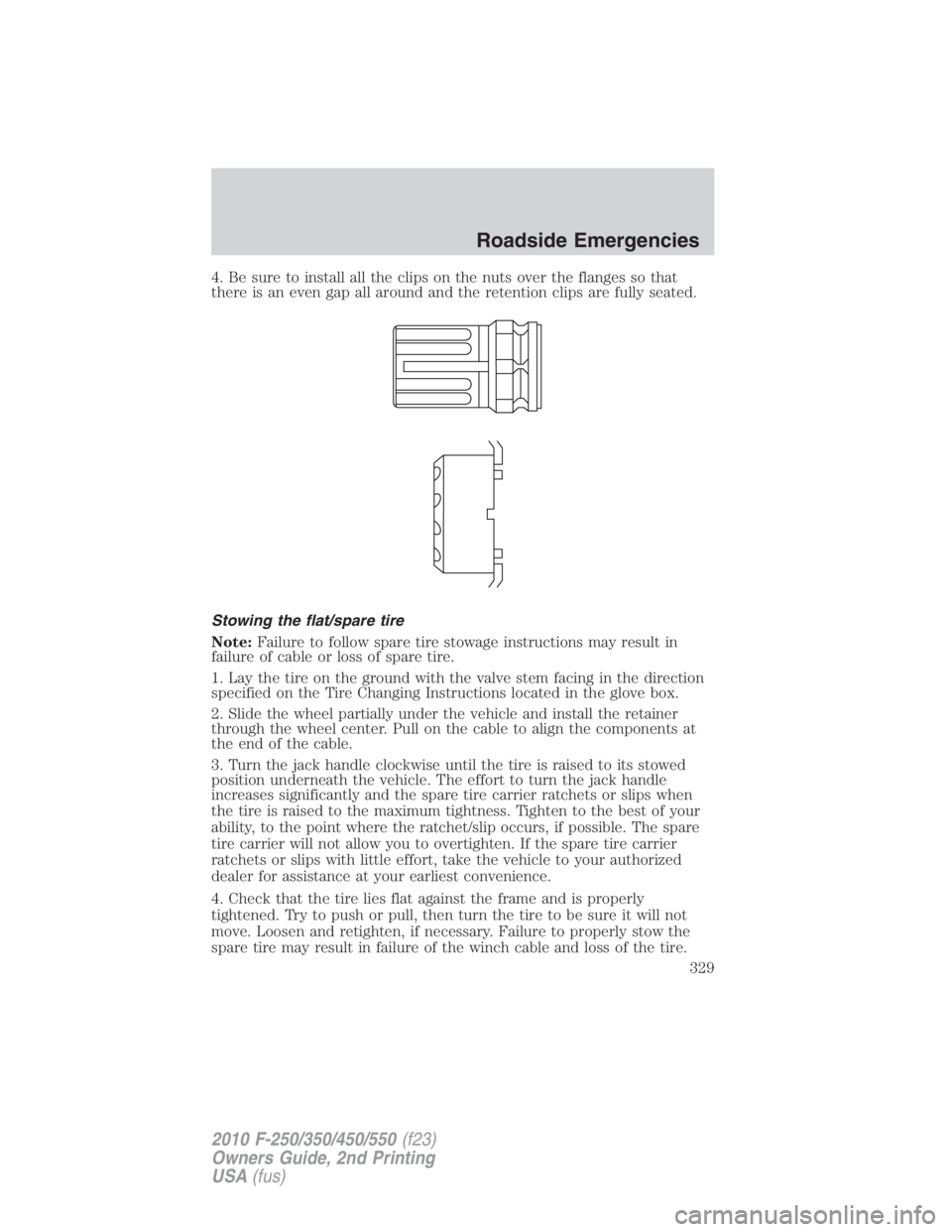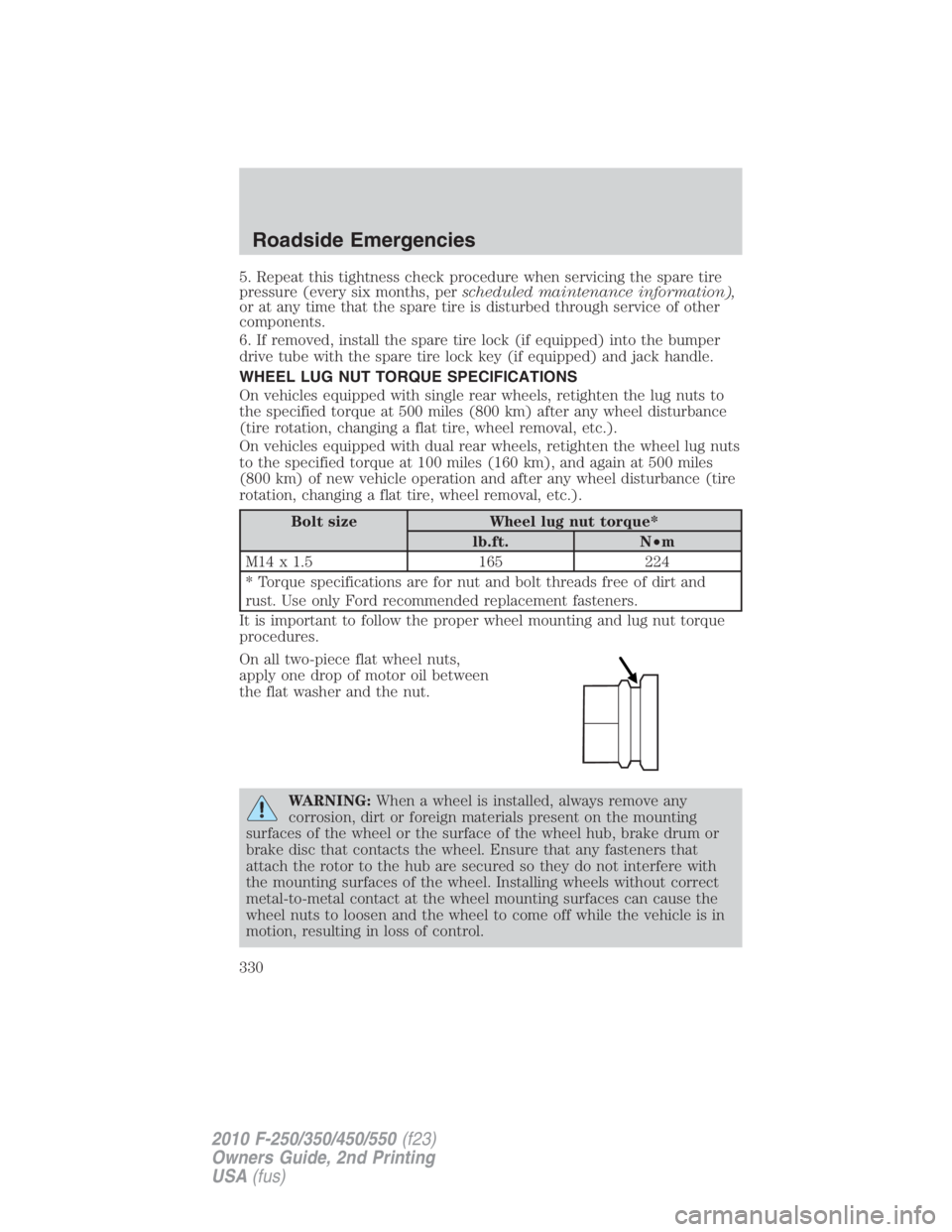Page 323 of 408

Never use the front or rear
differential as a jacking point.
WARNING: To lessen the
risk of personal injury, do
not put any part of your body
under the vehicle while changing a
tire. Do not start the engine when
your vehicle is on the jack. The
jack is only meant for changing
the tire.
7. Turn the jack handle clockwise
until the wheel is completely off the
ground and high enough to install
the spare tire.
8. Remove the lug nuts with the lug
wrench.
9. Replace the flat tire with the
spare tire, making sure the valve
stem is facing outward for all front wheels and single rear wheel vehicles.
If replacing an inboard rear tire on dual rear wheel vehicles, the valve
stem must be facing outward. If replacing the outboard wheel, the valve
stem must be facing inward. Reinstall the lug nuts until the wheel is
snug against the hub. Do not fully tighten the lug nuts until the wheel
has been lowered.
10. Lower the wheel by turning the jack handle counterclockwise.
Go to Step 19.
The following steps apply to F–350 Dual Rear Wheel (DRW) and
F–450/F–550 vehicles only:
11. Slide the notched end of the
jack handle over the release valve
and use the handle to slide the jack
under the vehicle. Make sure the
valve is closed by turning it
clockwise. Roadside Emergencies
323
2010 F-250/350/450/550 (f23)
Owners Guide, 2nd Printing
USA (fus)
Page 326 of 408
15. Remove the lug nuts with the lug wrench.
16. Replace the flat tire with the spare tire, making sure the valve stem
is facing outward on all front an inboard rear wheels. If replacing the
outboard wheel, the valve stem must be facing inward. Reinstall the lug
nuts until the wheel is snug against the hub. Do not fully tighten the lug
nuts until the wheel has been lowered.
17. Lower the wheel by slowly turning the release valve
counterclockwise. Opening the release valve slowly will provide a more
controlled rate of descent.
The following steps apply to all vehicles:
18. Remove the jack and fully
tighten the lug nuts in the order
shown. Refer to Wheel lug nut
torque specifications later in this
chapter for the proper lug nut
torque specification.
8–lug nut torque sequenceRoadside Emergencies
326
2010 F-250/350/450/550 (f23)
Owners Guide, 2nd Printing
USA (fus)
Page 327 of 408
10–lug nut torque sequence
19. Stow the flat tire. Refer to Stowing the flat/spare tire if the vehicle
is equipped with a spare tire carrier.
Note: Do not stow the Harley-Davidson flat tire and wheel using the
spare tire winch mechanism; store the flat in the bed of the truck.
20. Stow the jack, jack handle and lug wrench. Make sure the jack is
securely fastened so it does not rattle when driving.
21. Unblock the wheels.
The following step applies to F–250/F–350 Single Rear Wheel
(SRW) vehicles only:
22. When installing the wheel center
ornaments, ensure that the
ornament retention towers on the
back side of the ornament are
aligned with the studs/lug nuts. The
retention towers are designed to be
installed over the studs/nuts and
retain to the flange on the lug nut. Roadside Emergencies
327
2010 F-250/350/450/550 (f23)
Owners Guide, 2nd Printing
USA (fus)
Page 329 of 408

4. Be sure to install all the clips on the nuts over the flanges so that
there is an even gap all around and the retention clips are fully seated.
Stowing the flat/spare tire
Note: Failure to follow spare tire stowage instructions may result in
failure of cable or loss of spare tire.
1. Lay the tire on the ground with the valve stem facing in the direction
specified on the Tire Changing Instructions located in the glove box.
2. Slide the wheel partially under the vehicle and install the retainer
through the wheel center. Pull on the cable to align the components at
the end of the cable.
3. Turn the jack handle clockwise until the tire is raised to its stowed
position underneath the vehicle. The effort to turn the jack handle
increases significantly and the spare tire carrier ratchets or slips when
the tire is raised to the maximum tightness. Tighten to the best of your
ability, to the point where the ratchet/slip occurs, if possible. The spare
tire carrier will not allow you to overtighten. If the spare tire carrier
ratchets or slips with little effort, take the vehicle to your authorized
dealer for assistance at your earliest convenience.
4. Check that the tire lies flat against the frame and is properly
tightened. Try to push or pull, then turn the tire to be sure it will not
move. Loosen and retighten, if necessary. Failure to properly stow the
spare tire may result in failure of the winch cable and loss of the tire. Roadside Emergencies
329
2010 F-250/350/450/550 (f23)
Owners Guide, 2nd Printing
USA (fus)
Page 330 of 408

5. Repeat this tightness check procedure when servicing the spare tire
pressure (every six months, per scheduled maintenance information),
or at any time that the spare tire is disturbed through service of other
components.
6. If removed, install the spare tire lock (if equipped) into the bumper
drive tube with the spare tire lock key (if equipped) and jack handle.
WHEEL LUG NUT TORQUE SPECIFICATIONS
On vehicles equipped with single rear wheels, retighten the lug nuts to
the specified torque at 500 miles (800 km) after any wheel disturbance
(tire rotation, changing a flat tire, wheel removal, etc.).
On vehicles equipped with dual rear wheels, retighten the wheel lug nuts
to the specified torque at 100 miles (160 km), and again at 500 miles
(800 km) of new vehicle operation and after any wheel disturbance (tire
rotation, changing a flat tire, wheel removal, etc.).
Bolt size Wheel lug nut torque*
lb.ft. N • m
M14 x 1.5 165 224
* Torque specifications are for nut and bolt threads free of dirt and
rust. Use only Ford recommended replacement fasteners.
It is important to follow the proper wheel mounting and lug nut torque
procedures.
On all two-piece flat wheel nuts,
apply one drop of motor oil between
the flat washer and the nut.
WARNING: When a wheel is installed, always remove any
corrosion, dirt or foreign materials present on the mounting
surfaces of the wheel or the surface of the wheel hub, brake drum or
brake disc that contacts the wheel. Ensure that any fasteners that
attach the rotor to the hub are secured so they do not interfere with
the mounting surfaces of the wheel. Installing wheels without correct
metal-to-metal contact at the wheel mounting surfaces can cause the
wheel nuts to loosen and the wheel to come off while the vehicle is in
motion, resulting in loss of control.Roadside Emergencies
330
2010 F-250/350/450/550 (f23)
Owners Guide, 2nd Printing
USA (fus)
Page 408 of 408

tilting .......................................121
SYNC � ..........................................97
T
Tailgate ......................................143
Temperature control (see
Climate control) ..........................98
Tilt steering wheel ....................121
Tire Pressure Monitoring
System (TPMS)
Tires, Wheels and Loading ....237
Tires ...................................219–220
alignment ................................229
care ..........................................225
changing ..........................318, 320
checking the pressure ............224
inflating ...................................221
label .........................................236
replacing ..................................227
rotating ....................................229
safety practices .......................228
sidewall information ...............231
snow tires and chains ............243
spare tire .................................316
terminology .............................220
tire grades ...............................220
treadwear ........................219, 226
Towing .......................................251
recreational towing .................262
Trailer Brake
Controller-Integrated ..............256
trailer towing ..........................251
wrecker ....................................336
Traction control ........................271
Trailer Brake
Controller-Integrated ................256 Transfer case
fluid checking .........................388
Transmission
automatic operation ...............275
brake-shift interlock (BSI) ....274
fluid, checking and adding
(automatic) .............................384
fluid, checking and adding
(manual) .................................387
fluid, refill capacities ..............391
manual operation ....................278
Turn signal ................................112
U
Upfitter controls .......................137
USB port ......................................60
V
Vehicle Identification Number
(VIN) ..........................................396
Vehicle loading ..........................244
Ventilating your vehicle ...........267
W
Warning lights (see Lights) .......14
Washer fluid ..............................359
Water, Driving through .............299
Windows
power .......................................124
Windshield washer fluid and
wipers ........................................120
checking and adding fluid .....359
replacing wiper blades ...........359
Wrecker towing .........................336Index
408
2010 F-250/350/450/550 (f23)
Owners Guide, 2nd Printing
USA (fus)